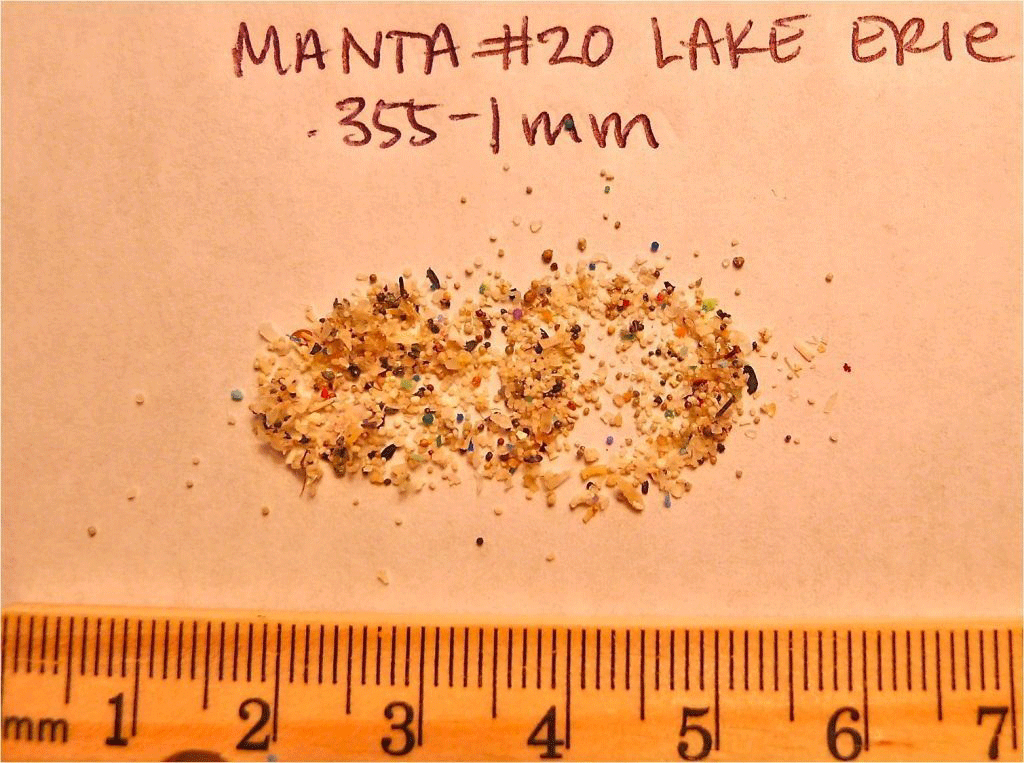Microbeads in the Great Lakes
CURWOOD: New York State recently introduced legislation to ban another hazard in the environment – a particular form of plastic called microbeads. Theyre tiny spheres of plastic that you find in skin care products like facial scrubs and exfoliants, but theyre so small, water treatment plants don't remove them and they end up in rivers and lakes. A recent study – the first of its kind – looked at plastic in the Great Lakes, and how it gets there. Kara Holsopple from the public radio program the Allegheny Front reports. HOLSOPPLE: Salon owner Marla Degenhart is enjoying a hand massage with a creamy French vanilla scrub. [SLATHERING SCRUB ON SKIN] DEGENHART: Thats awesome. [LAUGHS] It feels great. Very scrubby, and its also a little more exfoliating than the oatmeal. HOLSOPPLE: Degenhart makes the homemade scrubs herself for her Lunasea salon and spa in Pittsburgh. DEGENHART: Everything that I use, every ingredient that I use is biodegradable. Im very earth-conscious. Ive been like a hippie my whole life. I dont look like one, but I think like one. [LAUGHS] HOLSOPPLE: Degenhart adds oatmeal, fine pumice, and even ground up walnut shells to her exfoliating masks and cleansers. These natural skin care products are the kind that Dr. Sherri Mason says shed like to see more of. Shes from the State University of New York at Fredonia. Masons been pulling an ingredient in the commercial version of cosmetic scrubs out of the Great Lakes by the thousands – microplastics. MASON: About 60 percent of the microplastics we found were these perfectly round, spherical balls. And those definitely dont come from the degradation of larger plastic items. HOLSOPPLE: They come from face washes and cosmetics with small, colorful plastic beads – microbeads – that do the job of exfoliating skin. Mason and her team have been trawling the Great Lakes by boat for the last two summers, looking for plastic. Their work is the first study of plastics pollution within the Great Lakes, and one of the first on freshwater plastics pollution. Half of the plastic in oceans are microplastics–pieces about 1 to 5 millimeters. In the Great Lakes, its 80 percent – most of it in Lake Erie. Many of us think of plastic pollution as an eyesore–plastic cups and bottles floating near the beach. But little plastic pieces make their way into the Great Lakes first as those larger plastic items like bags or cups – trash that gets washed through storm drains. Then they get broken down by sun, wind, and water. In the case of microbeads, they come through municipal sewers. Mason says finding that so many of these microplastics were little beads was a surprise. And they could be creating big problems for wildlife. MASON: They essentially look like fish eggs. They look like food. The biggest concern is the possible ingestion of these microplastics by aquatic organisms. HOLSOPPLE: Mason says similar ocean studies show they are eaten by birds and fish–theyre so small even mussels and plankton – at the bottom of the food chain – can eat them. The plastics prevent wildlife from digesting real food, and that can kill them. But thats not the only issue. Mason says the Great Lakes were once a dumping ground, and even though pollution is more regulated now, some chemicals are persistent. Plastics found during Masons study had elevated levels of industrial chemicals like PCBs. Michelle Naccarati-Chapkis with Women for a Healthy Environment explains why. NACCARATI-CHAPKIS: Those dangerous chemicals can essentially bind to plastics. HOLSOPPLE: Her Pittsburgh-based groups been reaching out to other environmental groups in the Great Lakes region, asking them to put pressure on retailers to stop carrying products which contain hazardous chemicals. Theyre worried about chemicals which cant be removed through water treatment. Naccarati-Chapkis says it bioaccumulates; the fish eat these toxic-coated plastics and then we eat the fish. NACCARATI-CHAPKIS: So we know that it works up the food chain and as a result will impact human health as well. HOLSOPPLE: Naccarati-Chapkis, Sherri Mason and others say that eating fish from the Great Lakes – where commercial fishing is an important industry–could be dangerous because the toxins in the plastics the fish ingest could leach into their flesh that we eat as food.
Every day, reporters and producers at The World are hard at work bringing you human-centered news from across the globe. But we can’t do it without you. We need your support to ensure we can continue this work for another year.
Make a gift today, and you’ll help us unlock a matching gift of $67,000!
